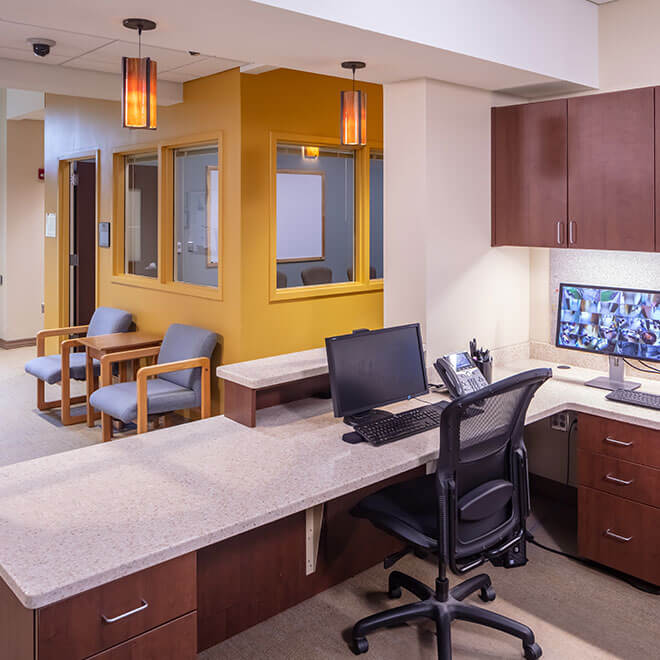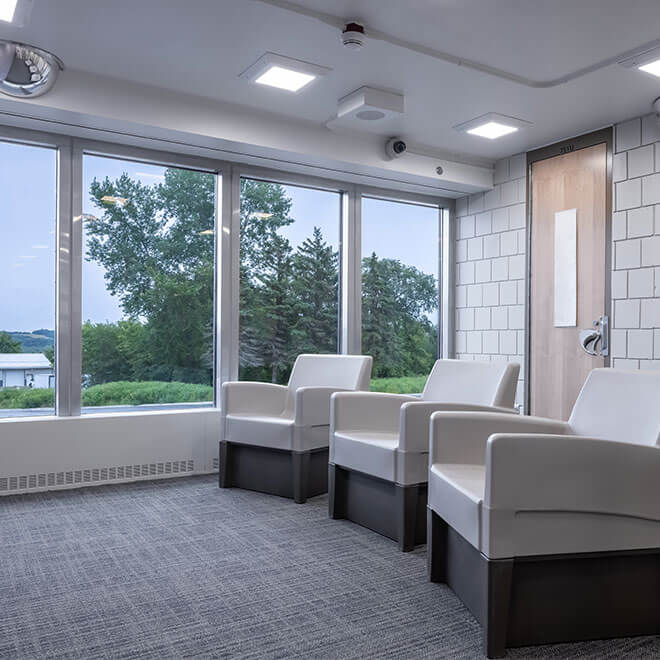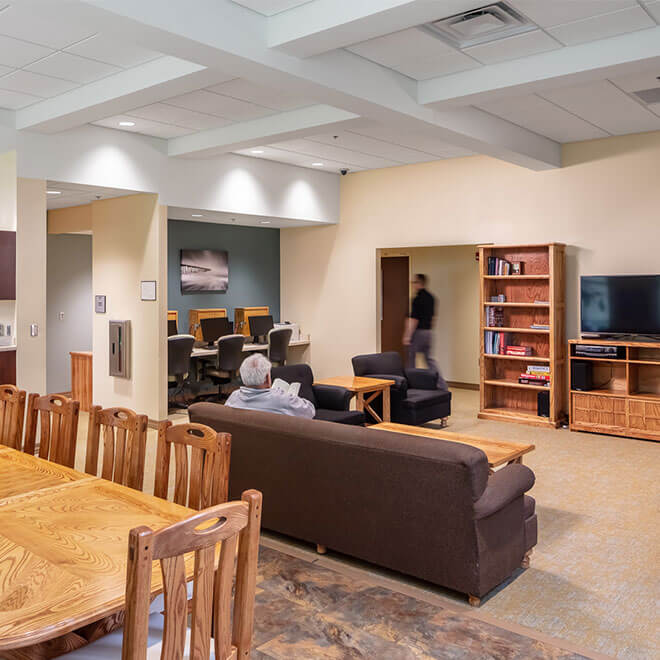Meeting the current and future needs of secure facilities — and the people they house and employ — is more important than ever before. As we face a nationwide mental health crisis and facility shortage, mental health needs must be prioritized and planned for at the onset of building secure facilities. Understanding the mission and goals of the facility is foundational to identifying the needs, products and technologies that will best fit the situation.
At Adolfson & Peterson Construction (AP), we consider all aspects of current and future needs from pre-planning to choosing which systems and levels should be utilized. We partner with owners, designers, subcontractors and vendors to introduce them to a variety of options, both new and old, to ensure the best-desired environment becomes a reality. This includes everything from natural light, soothing sounds and gradual lighting controls to transitional furniture, colors and controlling smells. We also consider the potential for a crisis to occur during construction and after and the various levels of security needed to ensure safety, such as ligature points and 24-hour surveillance cameras.

Prioritizing mental health at work in high-risk facilities
Adolfson & Peterson Construction has performed nearly a billion dollars in mental health and secured facilities construction projects — we are well known in the industry and understand the importance of prioritizing mental health in the workplace. We achieve optimal safety and prioritize mental health by focusing on specific strategies to ensure the safety and mental health of our team, the employees on-site and others when building high-risk facilities.
Mental health in the workplace continues to be a major focus in 2023 with more employers realizing in recent years the need to protect employees’ mental health and well-being and to make these efforts part of their organization’s attraction and retention programs. According to the American Psychiatric Association Foundation Center for Workplace Mental Health, organizations in the construction industry value and recognize the importance of making mental health more visible and sharing resources for the greater good of society and the construction industry as a whole. AP has been an active participant with the Minnesota Safety Council regarding their promotion of mental health and its awareness.
Our teams understand the importance of keeping everyone involved in the project safe, not only during construction but throughout the life of the building. This is why we are adamant about using the right products and tools for the appropriate situations — and keeping open lines of communication at all times. This is critical for all involved.

Intentional architecture in high-risk facilities
From maximum security to transitional care, the safety behind the design and execution of high-risk facilities continues to be a top priority. This includes not only prioritizing the safety of AP employees but also the patients and staff at the facilities.
According to Forbes Health, the trauma and stress associated with incarceration can exacerbate existing conditions and potentially contribute to new diagnoses such as depression, anxiety, PTSD and substance abuse. This is also true of the building process, especially when growing mental health concerns exist in the construction industry.
AP’s previous experience and portfolio of maximum-security projects provided the family-owned firm with relevant expertise and a unique perspective on how to keep staff and inmates/patients safe throughout the entirety of the project, from beginning to end. This starts with consistent, intentional communication to minimize impact and disruption, thoughtful planning and timely considerations and the implementation of strategic fences and boundaries to minimize crossover between workers and inmates/patients.
During the design stage of high-risk facilities, the incorporation of natural light, industrial-grade plastic over steel furniture, and adapting to different levels of security, therapeutics and building materials is also part of the process. The implementation of these factors significantly reduces the risk for employees and provides patients with comfortable yet secure settings. This is important not only the to end users but also to the workers who will build these spaces, as being in a dreary setting day after day will be taxing to their mental wellness while construction is ongoing.

The impact of physical surroundings on mental health
An individual’s physical surroundings have a large impact on our personal and overall mental health. May is Mental Health Month in the U.S., and this year, the focus is on the way our neighborhoods and built environments impact both individual and population mental health. This is not only important to our country collectively, but also to our organization at AP as we continue finding ways to incorporate positive impacts in our built environments.
According to Very Well Mind, environmental factors can impact mental wellness by changing brain structure and function. This further showcases the importance of ensuring that spaces that have become America’s de-facto mental health facilities be built, financed and structured to include intentional architecture for mental health.
Mental health must be prioritized and planned for at the onset of building secure facilities to accommodate and overcome the nationwide mental health crisis. Adolfson & Peterson Construction is actively making strategic advancements in the field to prioritize mental health for both inmates and employees.
